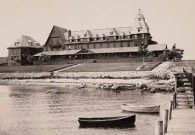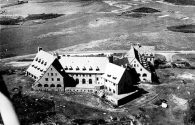
Mansion House Cottages on Bell Hill, circa 1913. Postcard published by Brown & Dawson. Museum Collection.
Island History
by Pierce Rafferty
In 1889, two brothers named Edmund and Walton Ferguson, both successful bankers, bought approximately ninetenths of Fishers Island from the Fox family. The new owners immediately began to implement a plan to transform Fishers Island from a day excursion destination into a more elite resort capable of attracting families to the island on a seasonal basis.
As part of their 1889 purchase, the Fergusons assumed control of the Fox-owned Mansion House, which had been operating as a hotel since 1877. A Colonial-era residence with a mid-19th century rear addition, it was located on an elevated rise beyond right field of today’s ball field. The historic Mansion House residence, minus the rear addition, still stands on this site.
Two years later, in 1891, the Fergusons purchased a second Fishers Island hotel, the Lyles Beach, from its private syndicate owners. This establishment had been operating as a boisterous day-excursion “shore hotel” since 1882. Blessed with an expansive waterfront view, the Lyles Beach fronted Fishers Island Sound at the entrance to West Harbor, west of the present-day location of the Three Sisters Cottages. After a major renovation, it reopened in 1892 under Ferguson management as the more elegant Munnatawket Hotel.
The Mansion House, despite its inland location and lesser water view (West Harbor was visible only at a distance), quickly evolved into the uncontested social epicenter of the island, a vibrant hub for a growing summer community then based entirely at the west end. It featured adjacent membership clubs—first the Casino (1895) and then the Hay Harbor Club (1909). By the mid-1910s, the Mansion House had three large extensions, each four stories high, that dwarfed the original structure. Each extension was named for its ground floor function: the dining room extension, the ballroom extension, and the living, or drawing-room, extension.
Between 1891 and the mid-1910s, the Fergusons built a total of 23 Mansion House Cottages and a children’s Diet Kitchen on the slopes of neighboring Bell Hill (today’s Shingle Hill). The families who rented these cottages could eat and socialize at the hotel’s central dining area, or they could have meals delivered directly to their homes. Not all of the cottages initially had kitchens. The cottages were usually rented for the full season, but in some instances they were let out for the half season.
During this period, as the Mansion House was expanding and flourishing, the Munnatawket Hotel took a parallel but opposite track. It was structurally reduced to a third of its size in 1905—The Day attributed the reduction to “poor business”—and then, surprisingly, it was rebuilt to its original size circa 1913. Whatever the size, however, it was by this time considered the Fergusons’ second-tier, or “medium-priced” hotel. By the early 1920s, the Munnatawket was leased to an outside hotel manager on a year-to-year basis at a bargain price. However, it sat unleased and empty for at least a year before it was finally razed in the mid-1920s.
This inglorious end to the once-proud Munnatawket raises the question: Why did the new Ferguson owners make the Mansion House their premier hotel when the better situated, newly renovated Munnatawket was also available? In addition to its superior water views, the Munnatawket had an adjacent bathing beach and a steamer pier within easy walking distance of the hotel’s front door.
A review of all available historical texts relating to the establishment of hotels on Fishers Island—primarily newspaper clippings, advertisements and promotional brochures—provided considerable evidence that the primary reason the Mansion House was favored was because the Fergusons felt that neighboring Bell Hill offered the best site for an associated cottage colony. The Fergusons wanted to attract private home builders to the island, but they first had to provide places for people to spend extended time here; thus, a cottage colony was seen as a critical first step on the path to populating the island. The proximity of sheltered Hay Harbor for safe bathing, swimming and boating was an additional positive factor.
It is not surprising that the Fergusons were enamored with cottage colonies; they were already quite familiar with this method of resort living from personal exposure to other private resort enclaves, including the South Fork Fishing and Hunting Club outside Johnstown, Pennsylvania (the record indicates as visitors, not members), and the newly established Jekyll Island Club in Georgia (initially as visitors, later members). In the last quarter of the 19th century, cottage colonies were widespread. Fishers Island had two such colonies established by the late-1870s, before the Fergusons first visited Fishers Island. There were the Bartlett Cottages that lined the road on Equestrian Avenue, stretching west from today’s round house (near the Duck Pond) along the southern edge of Hay Harbor, up onto the bluff that today supports the Baccile residence and the Bonsal’s adjacent “Anchorage.” Today’s Oswald, Guimaraes, Tapscott, Fowler, Cameron, and Bonsal residences (both the “Anchorage” and “Seven Gables”) were all once part of the Bartlett cottage colony. They were built for upscale clientele and featured a common dining cottage. When the E.M. Ferguson family first visited the island in 1883, they stayed at a Bartlett Cottage. According to a family account, however, in this instance they rejected the shared dining experience, preferring instead to eat and socialize on their private steam yacht.
The other early Fishers Island cottage colony, the Hoffort Cottages, overlooked West Harbor on the waterside of Montauk Avenue, just past today’s Texaco Station as you head toward The Gloaming. Today the Lighthouse Works’ artists reside in one of these former Hoffort Cottages, and the adjacent Nigro and Gaillard residences were also part of the colony. The proprietors, Mr. and Mrs. J.P. Hoffort, formerly of Middletown, Conn., targeted a middle class clientele.
A Hartford Courant reporter noted the merits of cottage colony living on Fishers Island in an article published on July 7, 1891: “A convenient way of providing for visitors prevails all over the island. Groups of cottages are maintained around a dining-room, and meals are furnished there for all at reasonable rates, while the cottages are rented furnished and with all service. The rooms are cared for by servants hired by those from whom the cottages are rented and all that the lodgers have to do is to enjoy life relieved of every care of housekeeping.”
Perhaps the most important takeaway from the historical research is that the Fergusons didn’t just want a single cottage colony next to their favored Mansion House Hotel: they wanted people to form other cottage colonies throughout the entire island. The earliest known Ferguson-era promotional brochure, dating from circa 1891, stated this desire clearly:
“It is house-builders or those who would form a colony, with central clubhouse, that the proprietors of the island are especially anxious to attract at this time…The colony arrangement has become an attractive and convenient feature of modern resort life. By which is meant an arrangement whereby a number of families occupy houses at convenient distances from one another and are fed at a club house or casino near at hand. To people desiring to form such colonies, by building, we offer special attractions.”
Please note that the casinos mentioned above were social and sports centers, not gambling establishments.
In subsequent promotional brochures published from the 1890s through the 1930s, the Fergusons continued to tout the many advantages of life in a cottage colony free from worry and housekeeping and with easy access to dining, dancing, social events and sports activities. This appears to have been a successful advertising campaign; Mansion House cottagers did bond to each other, including in marriage, and they bonded to Fishers Island as well, with many renters returning year after year, often to the same cottage. Over time, a number of the families who were renting chose to build summer homes on the island, which was the key component of the Fergusons’ long term plan. The lithographic color advertising brochure published by E.M. & W. Ferguson in 1897 was simply titled: “An Island of Homes.” In a 1905 legal interview regarding the estate of his deceased brother, Walton Ferguson explicitly stated: “we have maintained them [the hotels] merely as a means of advertising.”
Although developers and individual home builders never responded to the call for establishing other cottage colonies across the island, E.M. & W. Ferguson’s original vision came to fruition on a grand scale when the second generation of Ferguson owners initiated the Olmsted Plan in the mid-1920s. This ambitious development project converted the eastern two-thirds of Fishers Island from farming pastureland into a residential colony with an associated golf course and clubhouse. Instead of rental houses clustered near a hotel, the east end development featured privately-built summer mansions set within an 1800-acre “park” whose occupants were socially joined at the hip to a new epicenter: the “Big Club.” Although the Crash of 1929 severely reduced the number of east end houses built, and the ensuing Great Depression nearly ruined the development, nonetheless, the younger Fergusons managed to bring into existence what their elder relations had sought from the very beginning: a private colony for individual home builders allied with a unifying clubhouse. The rest, as they say, is history…



